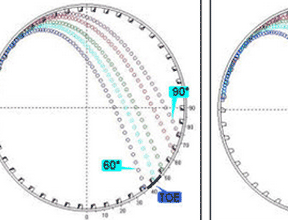Abstract
Powell, M.S. 1991. The effect of liner design on the motion of the outer grinding elements in a rotary mill. min. J. Miner. Process., 31: 163-193.
A theoretical analysis was made of the motion of an isolated rod or ball, and the way in which it is influenced by a lifter bar of any face angle and of any height. The charge motion of rods in a glass-ended mill was filmed with a high-speed camera. The mill was fitted with a variety of lifter bars with different face angles and heights, and was run at a wide range of speeds. The trajectories of the rods on film were then tracked. The coefficients of friction between the rods and the lifter bar materials were measured under the vibrating conditions that are found in the mill.
It was found that there was a good correlation between the theoretical predictions and experimental results over a wide range of conditions. The impact point at which The grinding element strikes the shell of the mill was considered to be of primary importance in the analysis. It was found that as the height of the lifter bar increases from zero to slightly greater than one charge radius, the height has a strong influence on charge trajectories. Thereafter, the lift increases until a critical lifter-bar height is reached. At heights beyond this, the grinding element is projected off the lifter bar prior to reaching the tip, with the height of the impact point increasing slightly and then decreasing to a constant height. The change in the height of the impact point is very small, however, so, in practical terms, an increase in lifter-bar height — once it is higher than the radius of the grinding element has only a slight effect upon the charge trajectories.
An increase in the angle of the lifter bars was found to have a strong influence upon the height of the charge trajectories. A linear relationship was discovered between the speed of the mill and the angle of impact, and changes in the mill speed strongly influence the charge trajectories.
Some surprising effects of lifter-bar geometry upon the charge trajectories have been discovered, and are of practical importance. The theoretical model is an improvement on all previous models, and agrees well with experimental results over a wide range of conditions.
Reference
International Journal of Mineral Processing, 31 (1991) 163-193
Elsevier Science Publishers B.V., Amsterdam
